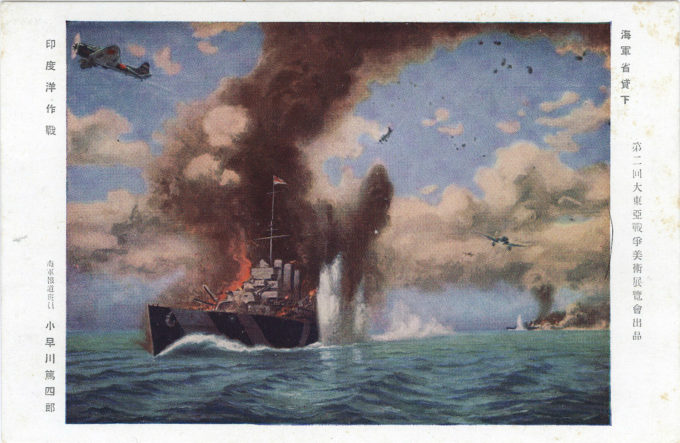
Indian Ocean raid (“Operation C”), Imperial Japanese Navy, 1942. The HMS Cornwall was among the British targets sunk as part of the Easter Sunday Raid on 5 April 1942 by Admiral Naguma’s carrier strike force.
See also:
Conquest of Singapore commemorative postcard, 1942.
The Japanese Occupation of Singapore, c. 1942.
Sinking the HMS Prince of Wales and HMS Repulse propaganda postcard, 1941.
“The Indian Ocean raid (known in Japan as ‘Operation C’) was a naval sortie carried out by the Imperial Japanese Navy (IJN) from 31 March to 10 April 1942. Japanese aircraft carriers, under the command of Admiral Chūichi Nagumo, struck Allied shipping and naval bases around Ceylon, but failed to locate and destroy the bulk of the British Eastern Fleet. The Eastern Fleet, commanded by Admiral Sir James Somerville, was forewarned by intelligence and sailed from its bases prior to the raid; its attempt to confront and attack the Japanese fleet was frustrated by poor tactical intelligence.
“The fall of Singapore on 15 February 1942 broke the United Kingdom’s eastern defensive perimeter of the Bay of Bengal; and Japanese occupation of the Andaman Islands on 23 March 1942 gave Japan control of the Andaman Sea enabling ships to resupply Japanese troops in the Burma Campaign for control of India. Both German and British authorities anticipated Japanese capture of Ceylon, strategically important because its location commanded the Indian Ocean and the source of much of the British Empire’s rubber, to solidify control of the Bay of Bengal and disrupt British resupply for defense of India, Australia, and perhaps the Middle East. Ceylon was hastily garrisoned by Australian troops returning from North Africa; and the aircraft carrier HMS Indomitable was relieved of naval duties to serve as a high-speed aircraft ferry shuttling available planes to Ceylon.
“… Admiral Isoroku Yamamoto issued the initial order to proceed with ‘Operation C’ to the IJN’s southern force, commanded by Admiral Nobutake Kondō, on 9 March 1942. By 16 March, the plan was to depart from Staring Bay, Celebes, on 26 March for an attack on Colombo (‘C day’) on 5 April. The Japanese expected to destroy the British Eastern Fleet in port. Japanese intelligence on the composition of the British Eastern Fleet was reasonably accurate, but overestimated air strength on Ceylon.
“The Japanese inflicted disproportionate damage on the enemy. They damaged port facilities, sank one carrier and two cruisers, destroyed a third of enemy ground-based fighters and nearly all of the enemy ground-based strike aircraft. In addition, 23 merchant ships were sunk. In return, the Japanese lost only 18 aircraft, with damage to about 31 more. However, the raid failed to destroy, or even locate, the main bulk of the British Eastern Fleet.
“The Japanese raid demonstrated that the RAF was too weak to defend Ceylon and the naval anchorages, and that the navy was ill-prepared to meet a Japanese carrier force. The Eastern Fleet transferred its main base to Kilindini, Kenya, in East Africa, temporarily ceding the eastern Indian Ocean to the Japanese; from there it continued contesting control of the central Indian Ocean on better terms for the next three years.”
– Wikipedia

